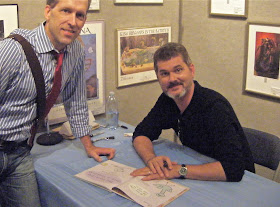 |
| At the Children's Museum of the Arts' "PoetTree Station" |
The goal was to raise $40,000 to continue art education in our school because Department of Education budget cuts slashed funding for this outstanding program.
As of this writing we have raised $21,410! The online auction is still underway so if you want to check out the fabulous items--from vacation packages to original artwork--click here.
The highlight of the evening for me centered around the nine award-winning children's book authors and illustrators who donated their time to attend the event. We were blessed to have Jim Benton, Peter Brown, Floyd Cooper, Tad Hills, Victoria Kann, G. Brian Karas, Ann M. Martin, Bob Shea and Dan Yaccarino in attendance.
I excitedly scooped up their magnificent books and headed off to the "library" section of the gallery to pose for pictures and get my treasures signed!
 |
| With Ann M. Martin author of The Baby-Sitters Club |
 |
| With Peter Brown author/illustrator of You Will Be My Friend and illustrator of Creepy Carrots! |
 |
| With Dan Yaccarino author/illustrator of Lawn to Lawn, Unloveable and Every Friday |
 |
| With Victoria Kann author/illustrator of Pinkalicious, Purplicious and Goldilicious |
I was asked to speak a few words about the program from my perspective as an educator. The gist of my speech celebrated the role of art in our schools as a counter balance to the ever increasing demands for standardized tests and assessments which dehumanize children into numbers and hinder policy makers from seeing them holistically.
All in all it was a great evening to support a worthwhile cause. A huge thank you to Kirsten Hall, Lucia Sheckner and the generous authors and illustrators for sharing their time and talent.
As Dave Bowell, our principal, pointed out in his speech..."Our EARTH without ART is just EH!"














